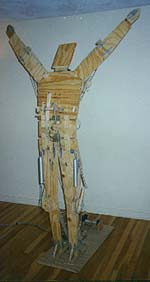
"…very cool" says Bruce P. of Boston MA
Click this to see 12 images of the Plywood Guy in various positions through his motion. (Total of about 200k of images).
Click this to see the Plywood Guy in motion!(This is a 240k animated GIF. "Worth the wait, I am assured," the website said for seven years. Now, 240k doesn't seem like so much, does it.)
Q. What the heck is that?
A. It's a guy made of plywood.
Q. Oh. That's weird, right?
A. That's what my wife said, but she's sticking by me.
Q. How does it work?
A. Assuming you mean the plywood guy: there's a single motor down on the base. The motor turns a crank. The crank is attached to a drum, which winds up a pair of nylon ropes. Here's a picture of the drive unit…
Q. Then what?
A. The ropes wind their way up through the body. As they go taut, the Plywood Guy starts to move. The thing is: because of latches placed all the way through the body, the motion happens in a programmed order. As you can see in the crouch sequence, the head goes forward first. That, in turn, releases catches on each shoulder, which allows the arms to come down, and so forth. Here's a picture of the upper back… you can see some of the catches, but you can't see the nylon monofilament (fishing line) that move them…
Q. So the thing bends at the waist, fine, but how come it doesn't fall back at the knees, or forward at the ankles?
A. Because of the asymmetric pantograph that links the foot to the calf, calf to thigh, and thigh to hips. In this picture, you can see the not-quite-parallel segments that join the lower body parts to each other…
Q. Does it actually cycle up and down as it appears in the animated GIF above?
A. No. The little control panel on the left has two switches. One is just an "on/off" switch (so you can stop it anywhere in its motion), and the other is a "stand/crouch" switch. So labeled, even little kids have no trouble understanding how to, er, "operate" it.
Q. Why did you build it?
A. Because I though it would be neat. The only thing is, it took months instead of an afternoon.
Q. Does it tell you anything about human physiology?
A. Yes! For one thing, it's no wonder the bad backs are such a common problem. Here's a picture of the springs and mounts at the lower back. The forces there are huge, and I have the advantage of leverage that the human, real human, pelvis does not!
Q. If I have other questions, can I ask them?
A. You bet! Send me email!.